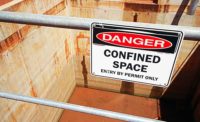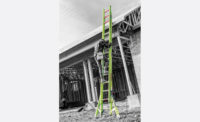Confined spaces can present severe safety hazards to the people working in them. To address these risks, OSHA created standards to make sure workers can get in and out safely, and do their jobs without endangering their health.
Companies have a responsibility to inform their workers and subcontractors about safety practices when working in confined spaces. OSHA Standard 1926 Subpart AA requires special training for workers who must enter and/or supervise a confined space where a physical or atmospheric hazard exists, or is reasonably likely to develop, that could interfere with a worker’s ability to exit the space.
A confined space is less dangerous if workers have had proper training. Training is important in helping workers recognize potential hazards and work safely in and around these spaces. Training is not only a good idea, but is also the law to train employees in a language and vocabulary they can comprehend. If training does not seem to be understood, then the training must be repeated until it is understood.
As companies build project plans, here are three key elements in creating a safe environment for workers that are operating in a confined space.
Be able to identify a confined space
OSHA requires employers follow set procedures whenever employees work inside or near a confined space. A confined space is an area large enough to bodily enter, has limited or restricted means of entry or exit and is not designed for continuous employee occupancy. Examples include tanks, underground vaults, manholes, tunnels, sewers, storm drains, equipment housings, crawlspaces and HVAC ducts. Open trenches and excavations, such as building foundations, are not subject to the rules of the confined space standard.
Typically, not every area that is considered a confined space is marked with a “danger” sign. This makes it vital that all workers know how to recognize a confined space and understand what to do if they have to enter one.
Comprehend confined space hazards
If the confined space poses a possible danger to health or life, or has a physical hazard that cannot be engineered out to safety, it is a permit-required confined space (PRCS). The best way to keep safe is to stay aware of the hazards and to recognize symptoms and warning signs of potential problems. Threats in a PRCS can include:
- Asphyxiation, caused by a lack of oxygen in the space or toxic gases, or poisoning by toxic gases.
- Injury from a fire and/or explosion if there is a buildup of dust or if flammable liquids are present.
- Shock or electrocution from electrical hazards.
- Injury from hazards associated with rotating or other mechanical equipment.
- Obstructions to access or egress points.
- Drowning from water or another liquid that engulfs the space.
- Heat exhaustion or heat stroke from a high ambient temperature.
- Respiratory problems due to dust buildup.
It is essential work crews recognize hazards that can be present in seemingly “normal” situations. Examples include a crawlspace where a generator is placed too close to the entrance, potentially filling the space with carbon monoxide, or a drainage shaft on a residential worksite that lacks sufficient oxygen, potentially rendering entering workers unconscious.
Take a team approach to safety
OSHA requires a general contractor, subcontractors and owner keep each other informed about potential dangers in a confined space. If someone sees or suspects a problem, they must let the other jobsite partners know about it immediately.
Looking at individual roles in a confined space, the entry supervisor has to sign the permit for the confined space before anyone can enter it, confirming all required tests have been conducted and acceptable entry conditions are found. If conditions become unsafe, the entry supervisor has to suspend the entry and the prohibited condition must be corrected before work can resume. They monitor the space to ensure those acceptable entry conditions are maintained. An entry supervisor must ensure a rescue team is available.
Before work begins at a jobsite, each employer must ensure a competent person identifies all confined spaces in which one or more employees it directs may work, and identifies each space that is a permit space through consideration and evaluation of the elements of that space, including testing as necessary.
Projects must have an entry attendant stationed outside the PRCS while workers are inside with the job to ensure employees can safely enter and work within the space. An entry attendant must stay in communication with workers in the space, alert them if there is a problem and call the emergency rescue team if necessary. An attendant can perform a non-entry rescue as specified by the employer’s rescue procedure. If the attendant is required to perform an entry rescue, they can only do so after the attendant has been relieved by another attendant. The relieved attendant may enter a permit space to attempt a rescue when the employer’s permit space program allows the attendant entry for rescue and the attendant has been trained and equipped for rescue operations.
If an entry rescue is required, the entry attendant can only perform that rescue if replaced by another properly trained person at the entry position. One person can serve as both entry supervisor and entry attendant if they have been trained for both jobs.
Authorized entrants into a confined space must know hazards they might face and the symptoms that indicate they have been exposed to those hazards. They must know how to use any necessary personal protective equipment (PPE) and make sure it is used. Authorized entrants are required to be in communication with the entry attendant. Authorized entrants must let the attendant know if they encounter a dangerous condition, or signs or symptoms that could indicate there is a hazard in the confined space.
Keeping workers in confined spaces safe is a team effort. Recognizing a confined space and understanding its dangers, along with all parties being trained on how to handle their safety responsibilities are essential to keeping workers safe.



